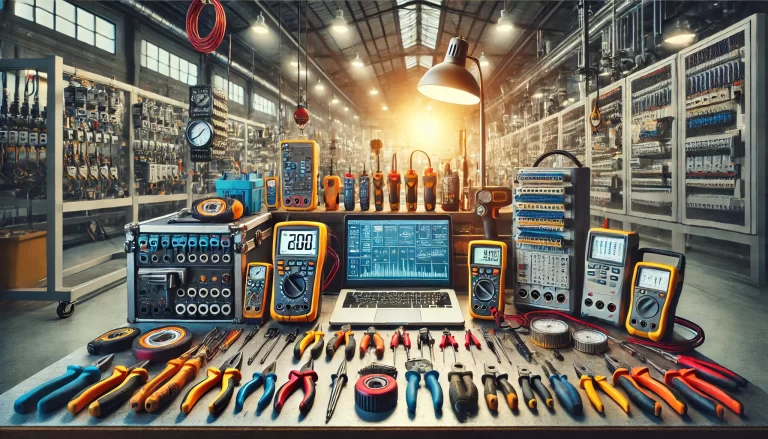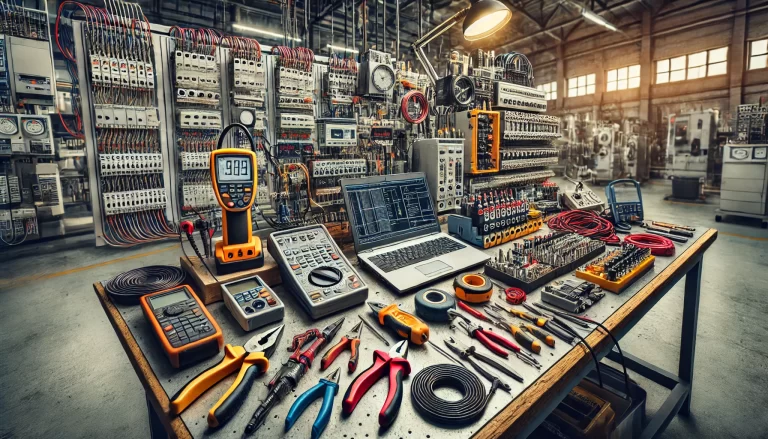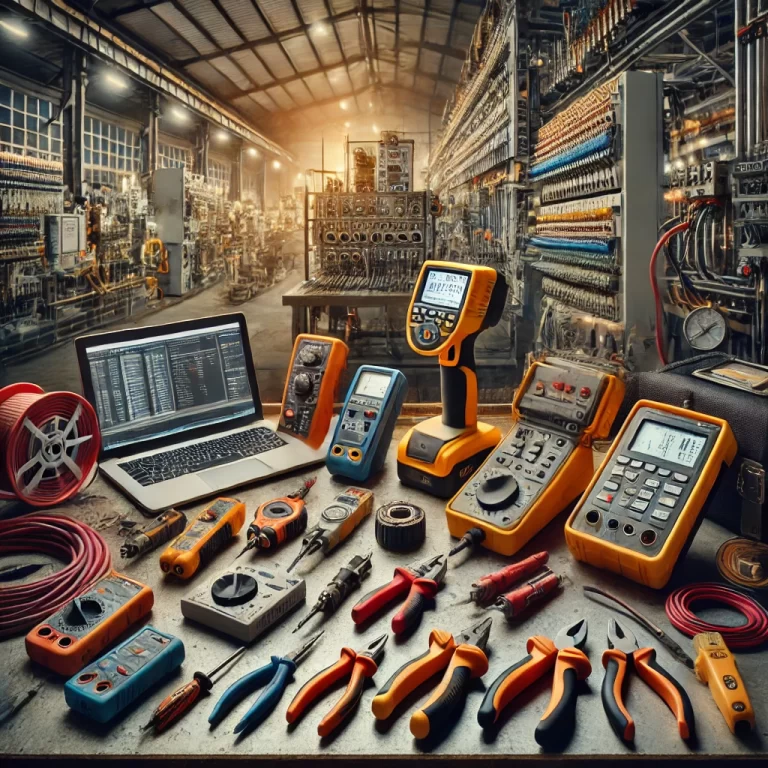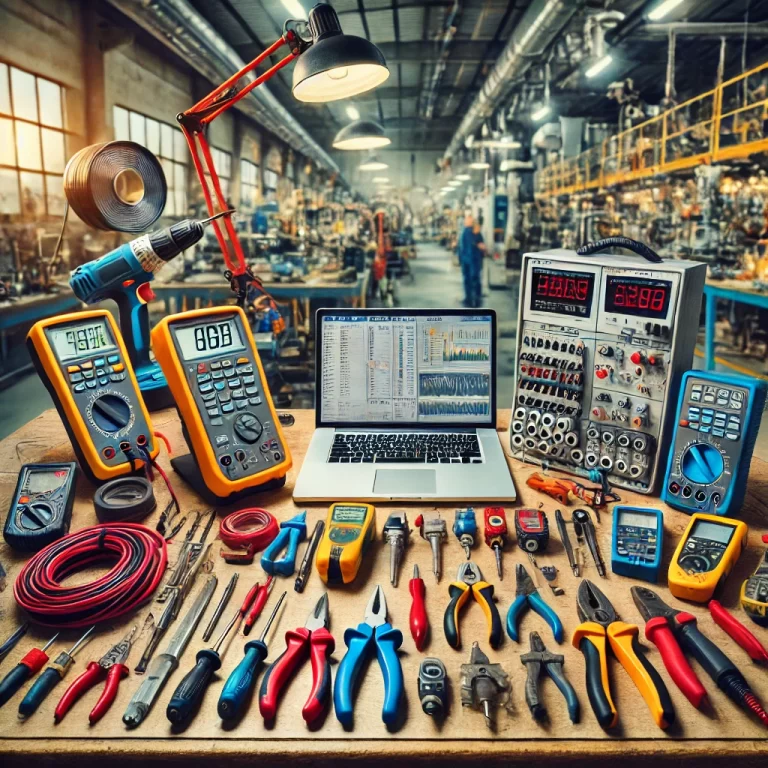Programmable Logic Controllers (PLCs) are the backbone of industrial automation, controlling processes and machinery across various industries. As a PLC engineer, working on-site involves a variety of tasks, from installation and programming to troubleshooting and maintenance. To ensure smooth operations, engineers must be equipped with the right tools and instruments. This article will provide a comprehensive overview of the essential tools every PLC engineer should have on hand when working in the field.
1. Electrical Tools
Electrical tools are a PLC engineer’s primary set of instruments. These tools are essential for wiring, troubleshooting electrical issues, and ensuring that all connections are functioning properly.
Multimeter
A multimeter is a must-have tool for any PLC engineer. It allows you to measure key electrical parameters such as voltage, current, and resistance. A digital multimeter (DMM) is particularly helpful for quick and accurate readings when diagnosing faults in the system.Clamp Meter (or Current Clamp)
A clamp meter is used to measure electrical current without the need to break the circuit. This tool is crucial when working in environments where accessing wires is challenging or where power must remain on while measurements are taken.Insulation Resistance Tester
This tool is used to measure the insulation resistance of electrical cables and components. Ensuring that the insulation of your electrical system is intact helps prevent potential shorts and ensures the system’s safety.Cable Strippers and Cutters
Cable strippers are used to strip the insulation off wires, while cable cutters allow for clean, precise cutting of wires and cables. Both are indispensable when setting up connections or making modifications to wiring.Crimping Tools
Crimping tools are used to attach connectors to cables. This is particularly useful for making reliable, secure electrical connections, especially in industrial environments where vibrations may loosen connections.Screwdriver Set
A complete set of screwdrivers (including flathead, Phillips, and other types) is essential for tightening and loosening screws that secure terminals, covers, and other components in the electrical system.Power Drill
When setting up control panels or electrical installations, a power drill is necessary for creating holes in various surfaces to mount hardware or pass cables through.Voltage Testers and Electrical Pen
A non-contact voltage tester helps determine whether an electrical system is live, ensuring safety before handling electrical components. Electrical pens are useful for quickly identifying voltage in circuits.

2. PLC Programming and Debugging Tools
When installing, programming, or troubleshooting PLC systems, specific tools are needed to ensure communication between PLCs and other devices, as well as to write and modify programs effectively.
PLC Programming Software
Software like Siemens Step 7, Rockwell Studio 5000, or Omron CX-Programmer is critical for programming and debugging PLCs. Engineers use these tools to create and modify control programs and ensure the PLC performs as intended. The software typically includes simulation and testing functions, enabling remote program modification.Programming Cables
Programming cables are essential for connecting the PLC to a laptop or PC for direct programming or troubleshooting. These cables often come in specific forms (USB-to-serial, Ethernet, etc.) depending on the PLC brand and model.Handheld Programmers
A handheld programmer allows PLC engineers to quickly modify the program or settings directly on-site. This portable tool can help when no computer is available or when quick on-the-go adjustments are necessary.HMI/SCADA Tools
Engineers often need to interact with Human-Machine Interface (HMI) systems to adjust settings and monitor real-time data. Tools for debugging and setting up HMI displays are essential for ensuring seamless communication between the operator and the PLC.USB-to-Serial Adapters
In some cases, PLCs use legacy serial communication. Having a USB-to-serial adapter on hand is essential for establishing connections between the PLC and your laptop or PC.

3. Communication Tools
In modern industrial systems, PLCs communicate with other devices, such as sensors, actuators, and supervisory systems. Communication tools are necessary for setting up, testing, and troubleshooting these connections.
Ethernet Cables and Switches
For industrial Ethernet communication, engineers need network cables (Ethernet cables) and network switches to establish connections between PLCs, HMIs, sensors, and computers.Wi-Fi and Bluetooth Communication Modules
In environments where wired connections are impractical, wireless communication tools like Wi-Fi or Bluetooth modules allow for remote configuration and data exchange between devices. This can be particularly useful for remote monitoring and troubleshooting.
4. On-Site Test Instruments
A range of test instruments is required to verify that the system is functioning properly and to monitor critical process parameters.
Pressure Gauges
Pressure gauges are used to measure the pressure of liquids or gases in pipelines or vessels. This is crucial for ensuring that systems operating under pressure are safe and functioning within their specified range.Flow Meters
Flow meters are used to measure the flow of fluids through pipes. Depending on the application, different types of flow meters (electromagnetic, turbine, or ultrasonic) may be necessary to ensure the system operates efficiently.Level Gauges
Level gauges measure the height of liquids or solids in tanks or silos. Common types include float-based level switches, capacitive level sensors, and radar level sensors, all critical for monitoring inventory levels in tanks.Temperature Sensors
Temperature sensors, such as thermocouples or RTDs (Resistance Temperature Detectors), are commonly used in industrial automation for monitoring temperature in processes that require precise thermal control.Humidity Meters
In environments where temperature and humidity control is vital, humidity meters are used to monitor and regulate moisture levels in the air, preventing equipment malfunction or damage.
5. Mechanical Tools
Though PLC engineers primarily deal with electrical and control systems, mechanical tools are essential when installing, mounting, or adjusting hardware.
Wrenches and Pliers
Engineers need various wrenches (open-ended, adjustable, and socket) and pliers (needle-nose, cutting) for tightening or loosening fasteners on panels and control devices.Torque Wrenches
A torque wrench ensures fasteners are tightened to the manufacturer’s specified torque value, preventing under-tightening or over-tightening that could damage components or cause failure.Calipers and Micrometers
These measuring instruments are essential for ensuring that components are installed to precise specifications, especially in cases where tight tolerances are required for machinery to function correctly.

6. Safety Equipment
Safety should always be a priority when working with electrical and industrial systems. Proper safety gear can prevent accidents and injuries.
Insulated Gloves
Insulated gloves protect engineers from electrical shock when working on live electrical circuits or in high-voltage environments.Safety Glasses
Safety glasses or goggles protect eyes from flying debris, sparks, or other potential hazards while working on-site.Hearing Protection
In noisy environments, engineers must use earplugs or earmuffs to protect their hearing from damaging noise levels.Steel-Toe Boots
Steel-toe boots are essential for protecting feet from heavy objects that may fall during installation, maintenance, or repairs.
7. Documentation and Data Storage Tools
Having access to the right documentation and being able to store data properly is key to managing PLC projects.
Laptops/Notebooks
A laptop or notebook is necessary for running PLC programming software, reviewing schematics, and storing logs or configurations on-site. Many engineers prefer having their own portable workstation when working in the field.USB Drives/External Hard Drives
Backup drives are important for ensuring that PLC programs, system configurations, and troubleshooting logs are stored safely and can be restored if necessary.Organizational Folders
Keeping technical manuals, schematics, wiring diagrams, and program codes organized ensures that engineers can quickly locate important documents when needed.
8. Portable Lighting
Finally, on-site work is often done in dimly lit areas, so portable lighting is crucial for ensuring safety and accuracy.
Flashlights
Compact flashlights are useful for spot-checking connections and inspecting hard-to-reach areas where overhead lighting may not be sufficient.Work Lights
For larger work areas, engineers need portable, rechargeable work lights to illuminate their workspace while keeping both hands free for tasks.

Conclusion
PLC engineers require a diverse array of tools and instruments to ensure successful on-site operations. These tools not only aid in the installation and programming of PLC systems but also enable engineers to perform efficient troubleshooting, maintenance, and system testing. By equipping themselves with the proper tools and instruments, PLC engineers can ensure optimal performance, safety, and efficiency in the field.
